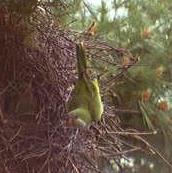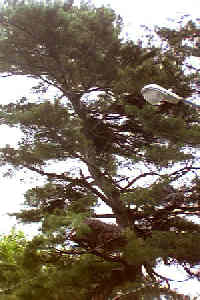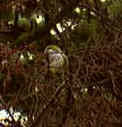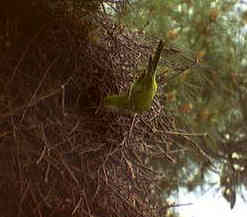MYIOPSITTA MONACHUS
The Monk or Quaker
Parakeet
An unexpected
sight on the University of Bridgeport campus are the green monk
parakeets.
Natives of Argentina, Brazil, Uruguay, Paraguay, and central Bolivia,
they have
been imported into the United States as pets. It is often said that in
the late
1960's, a container of parakeets was dropped and broke open at Kennedy
Airport
in New York. Several birds escaped and established wild populations in
Long
Island. While there is no evidence to
support this story, parakeets were imported into the United States as
pets in
the 1960's. Most likely some of these
did escape or were released into the wild when their owners found them
to be
undesirable pets. These individuals have
established colonies with populations reported from Branford to Norwalk.
On the U.B.
campus, the
parakeets nest in the white pine trees near Barnum Hall. The nests are
large
and made of sticks. One in the Black Rock section of Bridgeport
measured 9 feet
by 5 feet. Some nests in South America have been known to be as big as
15 to 20
cubic feet and weigh several hundred pounds. Within a nest, the nesting
chamber
is 7-9 inches in diameter and connected to the entrance hole by a short
tunnel.
The entrance hole is at the bottom or lower side of the nest. This is
apparently effective protection against predators. A single nest can
contain up
to 12 nestlings, with the average being five to nine. Most nests are
started by
a single pair of birds. Over time, the nest is added to by other pairs
of
birds. It is thought that the additional nests are established by
offspring of
the original pair.
As students in
Barnum Hall can
attest, the parakeets are noisy. These social birds are constantly
vocalizing
with squawks and shrieks as they work. Studies have identified eleven
different
vocalizations with different meanings.
Many people
are surpirsed that
these parakeets can survive our harsh winters. However, though the
birds are
native to equatorial countries in South America, they come from
mountainous
areas. Also, their nests are well built to insulate them from the cold
and
enable them to keep warm with body heat.
|
Parakeet Classification |
|
|
Kingdom ANIMALIA |
Eukaryotic,
multicellular, heterotrophic living organisms capable of muscular
movement. |
|
Phylum CHORDATA |
Animals with a dorsal
tubular nerve chord, notochord, pharyngeal gill slits, and post anal
tail at some time in their life cycle. |
|
Subphylum VERTEBRATA |
Chordates in which the
notochord has been replaced with a segmented backbone. |
|
Class AVES |
Warm-blooded
vertebrates with the forelimbs modified as wings, a horny beak, and
feathers covering the body. |
|
Order PSITTACIFORMES |
|
|
Family PSITTACIDAE |
|
LINKS TO MONK PARAKEETS
Monk Parakeets in North America
Institute for
Biological
Invasions
Monk
Parakeets: Why
here? Connecticut Audubon
Perfessor Birdsley's
Monk
Parakeet and Birding Pages
Return to Dr.
Singletary's page
Last Updated: June 30, 2009



